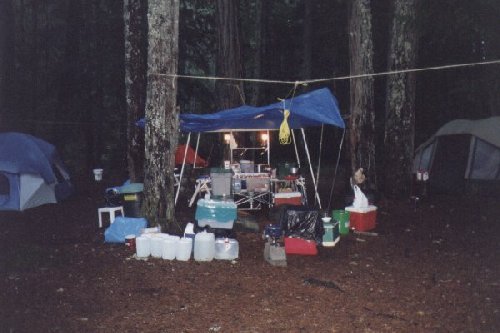November 10 -15, 1999
Big Bottom Outing (See map)
Big Bottom outing camp 11/99Nov. 10, 1999 - Wednesday
Steve went up and set marten traps along the Big Bottom area of the Clackamas. He has never trapped a marten and wants to bag one. With luck, he figures that he will get between one and three on this trip. He had to be back at 3 PM to pick-up his daughter from school. He left before light, but due to time said he only got 8 traps set. He wants to set about 3 dozen to get good coverage of a variety of terrain. The Big Bottom is one type of terrain he wants to test. The other two types of terrain are higher altitude woods along streams and high wooded areas.
The Big Bottom is a long, wide high mainly flat area up the main fork of the Clackamas River. It has much downed timber, plenty of feeder streams and a wide variety of tree sizes. Most of it has been logged at some time due to the ease of moving logs. On each side of the Bottom, ridge lines rise to about 5,500.' It is very picturesque. There is the river, some exposed rock cliffs, buttes and low mountains on the sides. Further south, snow capped Mt. Jefferson at 10,495' offers a spectacular view.The marten is a small weasel like animal that is somewhat rare. The marten eats mice, voles, squirrels and other small animals that live in the forest. The Oregon Dept. of Fish & Game likes to receive the carcass and catch data for each one taken. Steve needed to find special spots to place traps. They needed to be set near water - the best is running water - and spots that had lots of down wood.
The traps are little guys, like what you would use for big rats and other domestic pests. That's what he mainly traps - domestic pests. Domestic pests range from raccoons and moles to beavers that flood fields. Every year he even traps some otters that move into a fish farm.
Anyway, Trapper Steve nails up a chicken wing on a tree about 6 feet high. Below that he hangs the trap from two nails and then covers it with a cone of fir boughs. You can't see the trap. He then places a wire swing line to a nearby tree and attaches a long loose end of it to the trap. What happens is that the marten goes up the tree to the bait, the trap springs closed, jumps off the nails from the force of the blow and swings out between the trees. He uses a "conniebear" type of trap that is as humane as you can get. It generally delivers a quick death blow.
As additional attractants, he ties an artificial white feather lure to the swing wire. He puts that on a small fishing swivel so it rotates gently in any breeze. He also uses scent and what a scent he uses! It's based on skunk stink and Steve calls it "Big Stinky." The stuff is so powerful that he keeps it in a glass jar inside of another glass jar and you can still smell it. Wearing rubber gloves, he applies just a bit of it to the chicken wing with a twig. He crams the twig into the wing. Then he takes a white 35mm film can and nails it upside down above the chicken wing. Into the can he puts a cotton ball soaked with a little of the "Big Stinky." This gives additional rain protected scent and another light colored object for the forest creatures to see and investigate.All website content is © Copyright 2000, Joseph Hector Beelart, Jr. unless otherwise noted.
All rights reserved.


